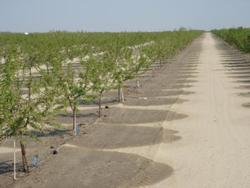State Water Efficiency and Enhancement Program (SWEEP)
1/19/22: SWEEP is now closed. If you submitted before Jan 19th, your application will be reviewed in the order it was received.
If you have been awarded and need assistance with your project, contact Caddie Bergren at (209) 385-7403.

SWEEP applications need to BOTH increase water savings and energy savings. Examples of eligible practices include:
| Water savings practices | Greenhouse gas savings practices |
|
Conversion from flood to drip or micro-sprinklers |
Variable frequency drive (VFD) |
| Electronic weather station linked to irrigation controller | Pump retrofit or replacement |
| Soil moisture sensors | Solar panels |
| Repair/replace leaky pipes | Pump conversion from diesel to electric |
What does this look like?
Here are a couple examples of successful SWEEP projects in the Central Valley :
- Vegetables
- With SWEEP funds, a farmer in Merced county converted from flood irrigation to drip irrigation in 18 acres of vegetables. She also added a variable frequency drive and solar panels to greatly decrease her greenhouse gas emissions and pumping costs.
- Almonds
- Alfalfa
- The West Star North Dairy received funding to transform the irrigation system of their alfalfa field from flood irrigation to 2-set drip irrigation.
- They installed a flow meter to measure water use, a new 50hp booster pump with a 50hp variable frequency drive, and a soil moisture probe.
- The dairy can now decrease their greenhouse gas emissions using the more efficient variable frequency drive and by reducing the amount of flooding in their fields, which can lead to methane emissions. It also increases water use efficiency by installing drip irrigation instead of continuing to use the less efficient flood system.
How to Apply
The grant process includes a web-based application consisting of a series of questions that can be saved and returned to before submitting.
Before you apply, you will need to gather three main pieces of information:
1. A pump efficiency test. For more information on how and where to get a pump test, click here.
2. The last twelve months of your energy records.
3. Quotes from vendors for the costs of your project components and installation.
Please note: The online application can be difficult, so we strongly encourage you reach out for free technical assistance in writing your application. Contact Caddie Bergren at (209) 385-7403 or cmbergren@ucanr.edu for questions and assistance.
To see what types of projects have been awarded previously, click here to view the list of 2019 awardees.

